pCI-neo:β2-365AAQA368 L349M
(Plasmid
#35610)
-
Depositing Lab
-
Publication
-
Sequence Information
Ordering
| Item | Catalog # | Description | Quantity | Price (USD) | |
|---|---|---|---|---|---|
| Plasmid | 35610 | Standard format: Plasmid sent in bacteria as agar stab | 1 | $89 | |
Backbone
-
Vector backbonepCI-neo
-
Backbone manufacturerPromega
- Backbone size w/o insert (bp) 5472
-
Vector typeMammalian Expression
-
Selectable markersNeomycin (select with G418)
Growth in Bacteria
-
Bacterial Resistance(s)Ampicillin, 100 μg/mL
-
Growth Temperature37°C
-
Growth Strain(s)Top10
-
Copy numberHigh Copy
Gene/Insert
-
Gene/Insert namenAChR beta2 L349M 365AAQA368
-
Alt nameB2 double mutant
-
Alt nameB2-DM
-
SpeciesM. musculus (mouse); mouse strain 129
-
Insert Size (bp)1555
-
MutationL349M and 365AAQA368
-
GenBank IDBC065103
-
Entrez GeneChrnb2 (a.k.a. Acrb-2, Acrb2, C030030P04Rik, [b]2-nAchR)
- Promoter CMV
Cloning Information
- Cloning method Restriction Enzyme
- 5′ cloning site EcoRI (not destroyed)
- 3′ cloning site EcoRI (not destroyed)
- 5′ sequencing primer T7
- 3′ sequencing primer T3
- (Common Sequencing Primers)
Resource Information
-
A portion of this plasmid was derived from a plasmid made byJ. Stitzel (University of Colorado, Boulder, CO)
Terms and Licenses
-
Academic/Nonprofit Terms
-
Industry Terms
- Not Available to Industry
Trademarks:
- Zeocin® is an InvivoGen trademark.
These plasmids were created by your colleagues. Please acknowledge the Principal Investigator, cite the article in which the plasmids were described, and include Addgene in the Materials and Methods of your future publications.
-
For your Materials & Methods section:
pCI-neo:β2-365AAQA368 L349M was a gift from Henry Lester (Addgene plasmid # 35610 ; http://n2t.net/addgene:35610 ; RRID:Addgene_35610) -
For your References section:
Nicotine up-regulates alpha4beta2 nicotinic receptors and ER exit sites via stoichiometry-dependent chaperoning. Srinivasan R, Pantoja R, Moss FJ, Mackey ED, Son CD, Miwa J, Lester HA. J Gen Physiol. 2011 Jan;137(1):59-79. 10.1085/jgp.201010532 PubMed 21187334



